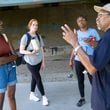The proposed cities of LaVista Hills and Tucker may be neighbors, but they’d have significantly different forms of government.
Each city would have contrasting city council structures, government services and tax rates.
Voters will likely decide in November whether to incorporate these communities, which share a border roughly along the eastern edge of I-285. Earlier this month, the Georgia General Assembly approved the cityhood legislation calling for the referendum, and it's pending before Gov. Nathan Deal.
Here’s how the governments of the two cities would vary:
- LaVista Hills would have a mayor and six city council districts, with each council member representing about 11,250 of the city's estimated 67,500 residents. Tucker's city council structure would be less typical, with a mayor and two council members from each of three districts. That amounts to one council member for every 5,550 of Tucker's 33,300 residents.
- Tucker would have a small local government providing three basic services: planning and zoning, code enforcement, and parks and recreation. LaVista Hills would include the same services as Tucker while also taking over police, roads and drainage, and permitting and licensing from the county. DeKalb County would continue to provide many other functions to both cities, including water and sewer management, courts, libraries and the sheriff's department.
- LaVista Hills' millage rate for property taxes would be capped at 5 mills unless voters approve a higher rate in a referendum. Tucker's tax rate would be limited to 1 mill unless voters support paying more in a referendum. Supporters of both LaVista Hills and Tucker say residents' overall tax burden will be the same or less than what they're currently paying to DeKalb County.
About the Author
Editors' Picks
The Latest






